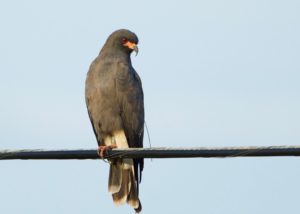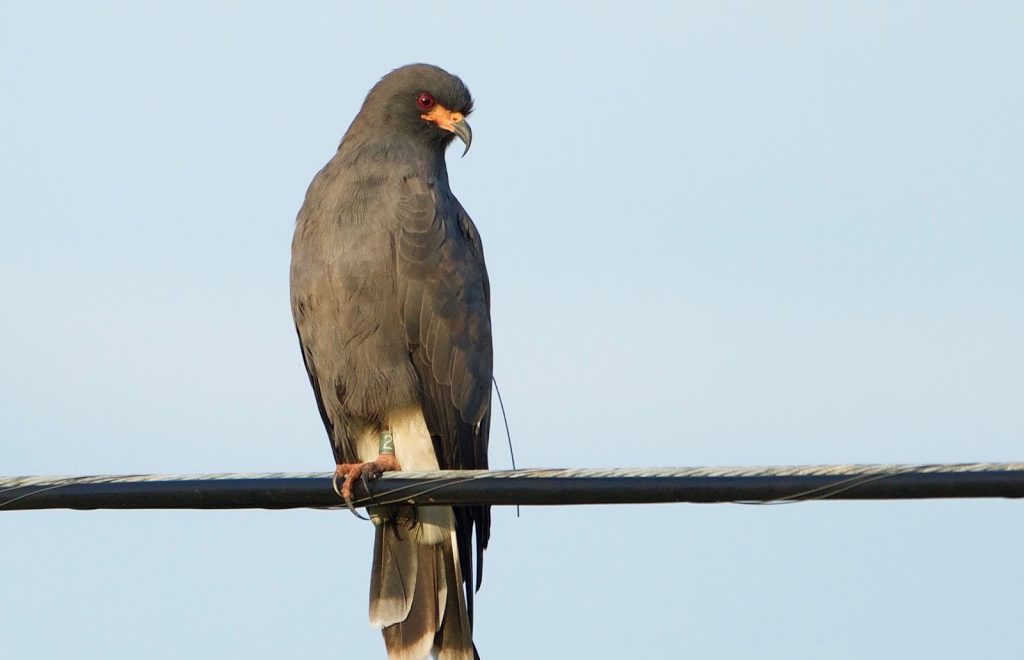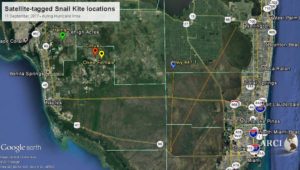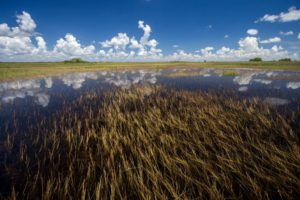In 2012, ARCI deployed satellite transmitters on twelve Snail Kites in peninsular Florida to study their movements in relation to habitat availability, site preferences, and use of publicly-owned conservation areas relative to unmanaged lands of various uses and conditions. Five years later, four of these birds are still providing the data that will help us inform critical management decisions for their species. These data have highlighted the Snail Kite’s refined adaptations for nomadism: we’ve seen the kites venture to other foraging or known nesting sites in a matter of hours and stay for weeks, months or, sometimes just hours.
 |
| Radio-tagged male Snail Kite on a power line. Photo credit Jack Haxby 2017. |
Because we have become so impressed with the kites’ extensive knowledge of the landscape gained from thousands of miles of traveling, we expected that these individuals had selected safe places to wait out Hurricane Irma. In fact, three of the four Snail Kites, all adult females, stayed in place as the storm came onshore in south Florida. One female, Harns hunkered down just 5 miles south of Harns Marsh in Lehigh Acres, her original capture location. The other two females, Okee Female and Citrus, chose to stay near Immokalee, Florida, a small agricultural town that was experiencing power outages, food shortages, and flooding long after the storm. Miraculously, these Snail Kites outlasted the eye of the then Category 3 hurricane, despite winds up to 129 miles an hour passing through that very area.
The fourth kite, adult male Hwy 441 1, made some last minute adjustments to his evacuation plan. On 6 September, as Hurricane Irma was wreaking havoc on the Caribbean and a mandatory evacuation was imposed on Florida Keys’ residents, he was south of Loxahatchee, Florida, near Twentymile Bend in Palm Beach County. On 8 September, he flew southwest to a freshwater marsh that is Snail Kite habitat just north of Tamiami Trail in Conservation Area 3A. However, on 10 September, as Irma drove on to Cudjoe Key, he zipped north 37 miles to a tiny tree island standing tall amidst wide-open marsh, where he weathered the storm. After a few days, well after the rain and winds had passed, Hwy 411 1 moved to within 3 miles of Okee Female just west of Immokalee, Florida, where he remains as of 20 September.
We will be monitoring the birds’ data closely over the next few weeks to see how they will respond to elevated water levels in their favorite feeding places. Of course, it’s easy to understand how low water levels reduce snail densities and abundance – and thus the presence of Snail Kites – in the wet-prairie habitats of south Florida marshes. However, too-deep water covers normally-emergent vegetation, such as Spike Rush. Apple Snails climb up the stems of such wet-prairie plants to breathe at the water’s surface, thus becoming available to foraging Snail Kites. As water levels in Florida’s unforested wetlands recede, Snail Kites will be behaving again like the nomads they are, searching for the places with just the right set of conditions that increase snail availability and the foraging success of this highly adapted aerial predator.
To see coarse, real-time movement maps of these four Snail Kites, remember you can follow them and our other satellite-tracked birds from our Satellite Tracking page on our website.




Leave a Reply